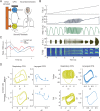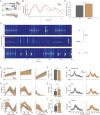Vocal development through morphological computation
- PMID: 29462148
- PMCID: PMC5834215
- DOI: 10.1371/journal.pbio.2003933
Vocal development through morphological computation
Abstract
The vocal behavior of infants changes dramatically during early life. Whether or not such a change results from the growth of the body during development-as opposed to solely neural changes-has rarely been investigated. In this study of vocal development in marmoset monkeys, we tested the putative causal relationship between bodily growth and vocal development. During the first two months of life, the spontaneous vocalizations of marmosets undergo (1) a gradual disappearance of context-inappropriate call types and (2) an elongation in the duration of context-appropriate contact calls. We hypothesized that both changes are the natural consequences of lung growth and do not require any changes at the neural level. To test this idea, we first present a central pattern generator model of marmoset vocal production to demonstrate that lung growth can affect the temporal and oscillatory dynamics of neural circuits via sensory feedback from the lungs. Lung growth qualitatively shifted vocal behavior in the direction observed in real marmoset monkey vocal development. We then empirically tested this hypothesis by placing the marmoset infants in a helium-oxygen (heliox) environment in which air is much lighter. This simulated a reversal in development by decreasing the effort required to respire, thus increasing the respiration rate (as though the lungs were smaller). The heliox manipulation increased the proportions of inappropriate call types and decreased the duration of contact calls, consistent with a brief reversal of vocal development. These results suggest that bodily growth alone can play a major role in shaping the development of vocal behavior.
Conflict of interest statement
The authors have declared that no competing interests exist.
Figures




Comment in
-
Towards an integrated view of vocal development.PLoS Biol. 2018 Mar 22;16(3):e2005544. doi: 10.1371/journal.pbio.2005544. eCollection 2018 Mar. PLoS Biol. 2018. PMID: 29565974 Free PMC article.
Similar articles
-
LANGUAGE DEVELOPMENT. The developmental dynamics of marmoset monkey vocal production.Science. 2015 Aug 14;349(6249):734-8. doi: 10.1126/science.aab1058. Science. 2015. PMID: 26273055
-
Vocal Learning via Social Reinforcement by Infant Marmoset Monkeys.Curr Biol. 2017 Jun 19;27(12):1844-1852.e6. doi: 10.1016/j.cub.2017.05.004. Epub 2017 May 25. Curr Biol. 2017. PMID: 28552359
-
Precise Motor Control Enables Rapid Flexibility in Vocal Behavior of Marmoset Monkeys.Curr Biol. 2018 Mar 5;28(5):788-794.e3. doi: 10.1016/j.cub.2018.01.070. Epub 2018 Feb 22. Curr Biol. 2018. PMID: 29478857
-
The role of auditory feedback on vocal pattern generation in marmoset monkeys.Curr Opin Neurobiol. 2020 Feb;60:92-98. doi: 10.1016/j.conb.2019.10.011. Epub 2019 Dec 10. Curr Opin Neurobiol. 2020. PMID: 31835132 Review.
-
Corollary Discharge Mechanisms During Vocal Production in Marmoset Monkeys.Biol Psychiatry Cogn Neurosci Neuroimaging. 2019 Sep;4(9):805-812. doi: 10.1016/j.bpsc.2019.06.008. Epub 2019 Jun 29. Biol Psychiatry Cogn Neurosci Neuroimaging. 2019. PMID: 31420219 Free PMC article. Review.
Cited by
-
A Hierarchy of Autonomous Systems for Vocal Production.Trends Neurosci. 2020 Feb;43(2):115-126. doi: 10.1016/j.tins.2019.12.006. Epub 2020 Jan 16. Trends Neurosci. 2020. PMID: 31955902 Free PMC article. Review.
-
Comprehension of own and other species' alarm calls in sooty mangabey vocal development.Behav Ecol Sociobiol. 2023;77(5):56. doi: 10.1007/s00265-023-03318-6. Epub 2023 May 23. Behav Ecol Sociobiol. 2023. PMID: 37234238 Free PMC article.
-
Born to sing! Song development in a singing primate.Curr Zool. 2021 Mar 4;67(6):585-596. doi: 10.1093/cz/zoab018. eCollection 2021 Dec. Curr Zool. 2021. PMID: 34805535 Free PMC article.
-
Increasing Muscle Speed Drives Changes in the Neuromuscular Transform of Motor Commands during Postnatal Development in Songbirds.J Neurosci. 2020 Aug 26;40(35):6722-6731. doi: 10.1523/JNEUROSCI.0111-20.2020. Epub 2020 Jun 2. J Neurosci. 2020. PMID: 32487696 Free PMC article.
-
Vocal Motor Performance in Birdsong Requires Brain-Body Interaction.eNeuro. 2019 Jun 25;6(3):ENEURO.0053-19.2019. doi: 10.1523/ENEURO.0053-19.2019. Print 2019 May/Jun. eNeuro. 2019. PMID: 31182473 Free PMC article. No abstract available.
References
-
- Chiel HJ, Beer RD (1997) The brain has a body: adaptive behavior emerges from interactions of nervous system, body and environment. Trends in Neurosciences 20: 553–557. - PubMed
-
- Tytell ED, Holmes P, Cohen AH (2011) Spikes alone do not behavior make: why neuroscience needs biomechanics. Current Opinion in Neurobiology 21: 816–822. doi: 10.1016/j.conb.2011.05.017 - DOI - PMC - PubMed
-
- Pfeifer R, Bongard J (2007) How the body shapes the way we think: a new view of intelligence: MIT press.
-
- Hauser H, Ijspeert AJ, Füchslin RM, Pfeifer R, Maass W (2011) Towards a theoretical foundation for morphological computation with compliant bodies. Biological cybernetics 105: 355–370. doi: 10.1007/s00422-012-0471-0 - DOI - PubMed
-
- Laschi C, Mazzolai B (2016) Lessons from Animals and Plants: The Symbiosis of Morphological Computation and Soft Robotics. IEEE Robotics & Automation Magazine 23: 107–114.
Publication types
MeSH terms
Substances
Grants and funding
LinkOut - more resources
Full Text Sources
Other Literature Sources
Molecular Biology Databases
Miscellaneous

